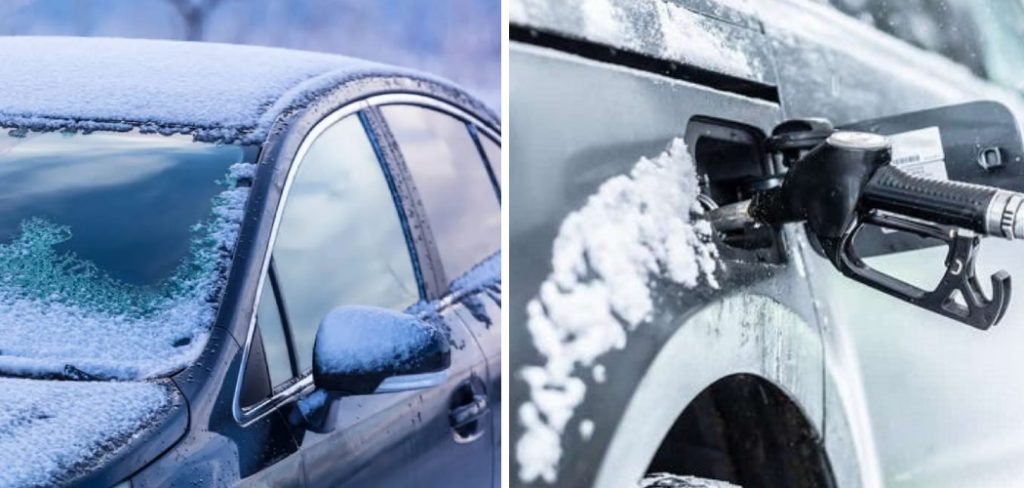Do you feel like you don’t know the first thing about fixing a frozen gas line in your car? Don’t worry, we have all been there at one time or another! This guide will take you through the process of diagnosing and repairing a frozen gasoline line in just a few easy steps.

Follow along to learn how to properly fix this common car problem and save yourself from an expensive repair bill. With our tips, tricks, and detailed guidance on how to fix frozen gas line in car, we’ll help get your car back on track as quickly as possible so that you can hit the road again without stress!
What Causes Frozen Gas Lines in Cars?
1 . Cold Weather
The most common reason why a gas line freezes is due to cold weather. When the temperature drops, it can cause moisture in the fuel lines to freeze and block the flow of gasoline to the engine. This usually happens when the temperature drops below 32 degrees Fahrenheit (0 degrees Celsius).
2 . Condensation
Another factor that contributes to frozen gas lines is condensation. As the temperatures fluctuate, moisture can build up inside the fuel lines and freeze, causing a blockage. This is more likely to happen if your car has been sitting for an extended period without being used.
3 . Water in Fuel
If you live in an area where temperatures frequently drop below freezing, using ethanol-blended gasoline can lead to frozen gas lines. Ethanol has a lower freezing point than traditional gasoline and can attract moisture, which then freezes and causes a blockage in the fuel lines.
4 . Blocked Fuel Filter
A blocked fuel filter can also cause a frozen gas line. If the filter is clogged with debris or dirt, it can restrict the flow of fuel and lead to a blockage in the lines. This is why it’s essential to regularly replace your car’s fuel filter.

5 . Insufficient Antifreeze
A lack of antifreeze can also contribute to frozen gas lines. Antifreeze not only helps keep your engine from freezing but also protects the fuel system by preventing moisture buildup. If there is not enough antifreeze in your car, it can increase the chances of a frozen gas line.
10 Ideas on How to Fix Frozen Gas Line in Car
If you find yourself with a frozen gas line, there are several steps you can take to fix the issue. Here’s what you can do:
1 . Warm Up Your Car
The first step is to warm up your car by turning on the engine and letting it run for a few minutes. This will help thaw out any ice that may have formed in the gas line. This will also help to circulate warm air through the fuel system and prevent further freezing.
2 . Use a Hair Dryer
If you have a hair dryer, you can use it to carefully warm up the frozen gas line. Be sure to keep the hair dryer at least a foot away from any fuel lines or other sensitive parts of your car. But make sure to not use an open flame or anything that could create sparks as this can be a fire hazard.

3 . Use Heated Blankets
If you don’t have access to a hair dryer, you can also use heated blankets or towels to wrap around the frozen gas line. This will help slowly thaw out the line without risking any damage to your car. Also, be sure not to use boiling water as this can cause the gas line to contract and potentially crack.
4 . Add Fuel Line Antifreeze
You can also add a fuel line antifreeze solution to your gas tank. This will help prevent your gas line from freezing in the future. Just make sure to follow the instructions on the product carefully. Also, be aware that this may take a few days to fully take effect.
5 . Check for Clogs
Sometimes, the issue with a frozen gas line is not just ice but also debris or clogs in the line. If your car has been sitting for a while, it’s possible that leaves, dirt, or other debris have accumulated in your gas tank. You can use a fuel line cleaner or take your car to a mechanic to have the lines checked and cleaned.
6 . Park in a Heated Garage
If you have access to a heated garage, consider parking your car there during winter months. This will help prevent your gas line from freezing in the first place. If you don’t have a heated garage, try to park your car in a covered area or use a car cover to protect it from extreme weather conditions.
7 . Use Fuel Additives
You can also add fuel additives, such as methanol or isopropyl alcohol, to your gas tank to help prevent your gas line from freezing. However, be sure to follow the instructions on the product and only use recommended amounts.
8 . Insulate Your Gas Line
To prevent your gas line from freezing, you can also insulate it with foam tubing or electrical heat tape. This will help keep the line warm and prevent ice from forming. Just make sure not to cover any ventilation areas as this could pose a safety hazard.

9 . Don’t Let Your Tank Get Too Low
Try to keep your gas tank at least half full during winter months. This will help prevent water from accumulating in the tank and freezing, which can lead to a frozen gas line.
10 . Consult a Mechanic
If you’re having recurring issues with a frozen gas line, it’s best to consult a mechanic for further assistance. They can check for any underlying issues and provide recommendations for preventing future freeze-ups.
By following these steps, you can easily fix a frozen gas line in your car and prevent it from happening again. Remember to always prioritize safety when dealing with any car maintenance issue. Stay warm and drive safely!
Frequently Asked Question
What Precautions Can I Take To Avoid This Situation?
There are many precautions you can take to avoid a frozen gas line in your car. The first step is to always make sure that your car has enough fuel, which will help prevent moisture from accumulating in the gas tank.
If you live in an area with extremely cold temperatures, it is recommended to keep your car indoors or use a car cover to protect it from the cold. Additionally, you can add a fuel line antifreeze additive to your gas tank before the temperatures drop. This will help prevent water from freezing in your gas lines.
How Do I Know If My Gas Line is Frozen?
The most common sign of a frozen gas line is when you have difficulty starting your car or if it stalls soon after starting. Your car may also sputter while driving, have reduced power, or refuse to start altogether. If you suspect your gas line is frozen, it’s important to check it as soon as possible.
What Steps Can I Take To Fix a Frozen Gas Line?
If your gas line has already frozen, there are a few steps you can take to fix the issue. First, try pouring a bottle of fuel injector cleaner into your gas tank and let it sit for 15-20 minutes. This may help melt any ice that has formed in the lines. If this doesn’t work, you can also use a hairdryer to blow warm air onto the gas line. Be sure to keep a safe distance from the engine and be careful not to melt any plastic components. Once the gas line is thawed, you may need to add more fuel or restart your car a few times before it runs smoothly again.
How Can I Prevent My Gas Line From Freezing Again?
To prevent your gas line from freezing in the future, make sure to use a good quality fuel line antifreeze additive and keep your gas tank at least half full during cold weather. You can also try using a fuel line heater or insulated fuel lines to keep the gas from freezing. If you notice any water in your gas tank, be sure to drain it before adding more fuel.

Conclusion
Overall, tackling the challenge of a frozen gas line in your car can be daunting if you’ve never done it before. However, by following the simple steps outlined in this post, you should be more confident when it comes to dealing with a frozen gas line in your car. So don’t let an icy winter be the end of your vehicle – take action now and remember the advice we have given so that you will be able to drive again soon.
Now you know how to fix frozen gas line in car! Proactively taking preventative measures is always better than having to fix something on the spot. Know how to deal with icy temperatures, parking garages, and cold climates so that you can drive confidently even when temperatures drop.
